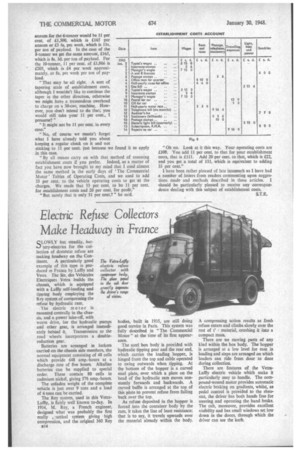Electric Refuse Collectors Make Headway in France
Page 52

If you've noticed an error in this article please click here to report it so we can fix it.
Q LOWLY but steadily, battery-electrics for the collection of domestic refuse are making headway on the Con
tinent. A particularly good example of this type is produced in France by Laffly and Vetra The Ste, des Vehicules Electriquei Vetra builds the chassis, which is equipped with a Lally self-loading and tipping body employing the Rey system of compressing the refuse by hydraulic ram.
The electric motor is mounted centrally in the chassis, and a power take-off, with worm drive, for the hydraulic pumps and other gear, is arranged immedi ately behind it, Transmission to the road wheels incorporates a doublereduction gear.
Batteries are arranged in lockers carried on the chassis side members, the normal equipment consisting of 48 cells which provide 648 amp.-hours at a discharge rate of five hours. Alkaline batteries can be supplied to special order. These contain 80 cells in cadmium nickel, giving 576 amp.-hours.
The unladen weight of the complete vehicle is just over 9 tons and a load of 6 tons can be carried.
The Rey system, used in this VetraLaffly, is fairly well known to-day. In 1934, M. Rey, a French engineer, designed what was probably the first really ractical system giving high compression, arid the original 360 Rey bodies, built in 1935, are still doing good service in Paris. This system was fully described in "The Commercial Motor" at the time of its first appearance.
The steel box body is provided with hydraulic tipping gear and the rear end, which carries the loading hopper, is hinged from the top and cable operated to swing outwards when tipping. At the bottom of the hopper is a curved steel plate, over which a plate on the head of the hydraulic ram moves constantly forwards and backwards. A curved baffle is arranged at the top of this plate to prevent refuse from falling back over the top.
As refuse deposited in the hopper is forced into the container body by the ram, it takes the line of least resistance; that is to say, it travels upwards over the material already within the body. A compressing action results as fresh refuse enters and climbs slowly over the rest of t' material, crushing it into a compact mass.
There are no moving parts of any kind within the box body. The hopper is arranged at a low level for ease in loading and steps are arranged on which loaders can ride from door to door during collection.
There are features of the VetraLaffly electric vehicle which make it particularly easy to handle. The compound-wound motor provides automatic electric braking on gradients, whilst, as pedal control is provided to the rheostat, the driver has both hands free for steering and operating the hand brake. The cab, moreover, provides excellent visibility and has small windows set low clown in the doors, through which the driver can see the kerb.
























































































